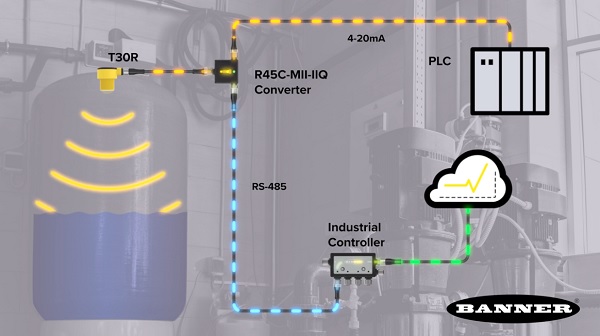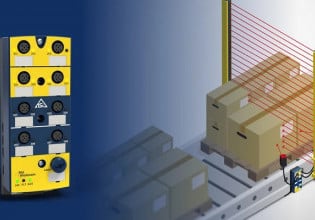Banner Engineering Releases a New Analog Input/Output Converter
Banner Engineering augments the Snap Signal series with a new converter that transmits analog I/O signals and converts them to Modbus or IO-Link.
Devices that use analog signals typically require some analog card on an I/O rack. Depending on the manufacturer, these analog cards can be two to three times the cost of a standard discrete I/O card. While analog signals have existed since the beginning of automation, they are still beneficial for controlling or monitoring purposes.

Banner’s new R45C analog to Modbus converter. Image used courtesy of Banner Engineering
Analog Converters
Typically, sensors that measure process variables will output in an analog format, such as temperature or pressure sensors. Variable frequency drives will also commonly have an analog input and an analog output for setting and monitoring current frequency.
Recently, Banner Engineering released a compact converter series that can convert analog input or output and broadcast the signal over Modbus TCP while still relaying the analog signal to the original controller without disturbing the process or requiring a complete system overhaul.

Oil refineries and other process-related industries (dealing with flow, pressure, temperature, etc.) make extensive use of analog controls. Image used courtesy of Adobe Stock
R45C Analog Converter
Built on the Snap Signal platform, the R45C can read analog signals, in both current or voltage, and output the signals on a Modbus protocol. The R45C has two female four-pin connectors which support one analog input and output channel per connector, providing 2-channel communication in one device. For the Modbus connection, the R45C uses a five-pin male connector, including a pin for 12-30 VDC power and a connection for Banner Engineering’s 1-wire sensors.
The R45C is available in six different models, two Modbus and the other four IO-Link. The two Modbus models provide an internal impedance appropriate for either current or voltage input and output, while the IO-Link models have the same circuit characteristics but with the added input or output option.

The system architecture of the R45C passes the original analog signal while supporting a simultaneous digital network protocol. Image used courtesy of Banner Engineering
The models have an input voltage range of 0-11 v and a current range of 0-24 mA for the voltage and current models, respectively. The analog signal is converted to a numerical representation and placed on different Modbus registers. Indicating LEDs are visible from both sides of the device and show Modbus status, power status, analog 1 in/out status, and analog 2 in/out status. The device uses industry-standard M12 connectors and measures 78 x 60 x 7 mm. The R45C can be easily mounted to surfaces using the 4.5mm through-hole in the center of the device.
Applications of Digital Networks
Analog signals are still used extensively in the automation industry, specifically in process control industries. The analog signal allows designers to collect measurements from the environment or process. Getting the analog signal onto an industrial protocol is always an expensive adventure if you don’t have an I/O rack close enough to the sensor or amplifier. Special cables and specific electrical grounding need to be designed into the system if your analog signal needs to travel long distances. Long cable runs of analog signals are also susceptible to electrical noise through EMI (electrical magnetic interference). By converting the analog signal onto the industrial protocol, you can now transmit that signal much further.
A common use of this device would be a tank-level detection sensor. Typically, the sensors are placed at the top of very large tanks, with the control system or RTU commonly placed at ground level. Running an analog signal cable of that length can cause signal degradation, so by using a device like the R45C and sending Modbus signals, you can reduce expensive cable runs and signal degradation.





